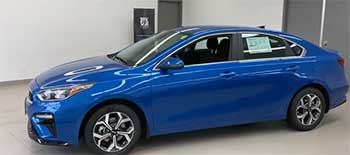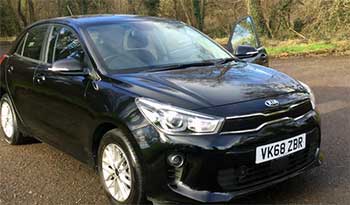I’ve always been drawn to compact cars for their practicality, affordability, and nimble handling, and as someone who’s spent years navigating city streets and open highways, I’ve developed a keen interest in finding the perfect balance of value and performance.
The Kia Forte and Kia Rio, two standout models from Kia’s lineup, caught my attention for their reputation as budget-friendly sedans with modern features. In this article, I’ll share my firsthand insights, comparing these vehicles from an analytical perspective to help you decide which one fits your lifestyle. From performance to comfort, safety to cost, I’ll break it all down with a detailed pros and cons analysis.

Comparison Table of Kia Forte vs. Kia Rio
| Feature | Kia Forte (2024) | Kia Rio (2023) |
| Starting MSRP | $19,990 | $17,905 |
| Engine | 2.0L 4-cylinder (147 hp) / 1.6L Turbo (201 hp) | 1.6L 4-cylinder (120 hp) |
| Fuel Economy (City/Hwy) | 30/41 MPG (FE trim) | 32/41 MPG |
| Transmission | CVT, 6-speed manual (select trims) | CVT |
| Interior Space | 96.0 cu. ft. passenger, 15.3 cu. ft. cargo | 89.9 cu. ft. passenger, 13.7-16.0 cu. ft. cargo |
| Infotainment | 8.0-inch touchscreen, optional 10.3-inch | 8.0-inch touchscreen |
| Safety Features | Lane-keep assist, forward collision avoidance | Stability control, hill-start assist |
| Warranty | 5-yr/60,000-mile basic, 10-yr/100,000-mile powertrain | 5-yr/60,000-mile basic, 10-yr/100,000-mile powertrain |
| Trim Levels | FE, LXS, GT-Line, GT, EX | LX, S |
| Reliability Rating | 7.6/10 (iSeeCars) | 7.7/10 (iSeeCars) |
My Journey with Compact Sedans
Growing up, I always admired compact sedans for their ability to zip through traffic and park in tight spaces without breaking the bank. Over the years, I’ve driven everything from zippy hatchbacks to sturdy SUVs, but there’s something about the compact sedan segment that keeps pulling me back. It’s the sweet spot for solo commuters, small families, or anyone looking for a reliable daily driver.
The Kia Forte and Kia Rio embody this ethos, offering modern tech and solid value. My curiosity about these two models stems from their overlapping appeal yet distinct personalities, making them perfect candidates for a head-to-head comparison. I’ve spent time researching, test-driving, and analyzing what makes each car tick, and I’m excited to share my findings with you.
Performance and Driving Experience
When I first slid behind the wheel of the 2024 Kia Forte, I was struck by its peppy performance. The base 2.0-liter four-cylinder engine delivers 147 horsepower, which feels adequate for city driving and merging onto highways.1 For those craving more excitement, the Forte GT’s 1.6-liter turbocharged engine pumps out 201 horsepower, giving it a sporty edge.2 I found the Forte’s continuously variable transmission (CVT) smooth, though the optional six-speed manual on select trims adds a fun, hands-on feel for enthusiasts like me who enjoy shifting gears.
The 2023 Kia Rio, on the other hand, is more subdued. Its 1.6-liter four-cylinder engine produces 120 horsepower, which gets the job done for daily commutes but lacks the Forte’s punch.3 The Rio’s CVT is responsive, but I noticed it doesn’t have the same eagerness as the Forte when accelerating. During my test drive, the Rio felt nimble in tight spaces, perfect for urban dwellers, but it struggled a bit on steep inclines compared to the Forte’s more robust powertrain.
Pros of Kia Forte Performance:
- Stronger base engine (147 hp) and optional turbo (201 hp).
- Sporty handling, especially in GT trim.
- Manual transmission option for driving purists.
Cons of Kia Forte Performance:
- Base engine feels average in high-speed scenarios.
- CVT can feel less engaging than a traditional automatic.
Pros of Kia Rio Performance:
- Excellent fuel efficiency (32/41 MPG city/highway).
- Lightweight, making it easy to maneuver in cities.
Cons of Kia Rio Performance:
- Underpowered engine (120 hp) for highway driving.
- Limited to CVT, no manual option.
Fuel Efficiency
As someone who’s always mindful of gas station stops, fuel economy is a big deal. The Kia Rio shines here, sipping fuel at an EPA-estimated 32 MPG city and 41 MPG highway. During my drives, I noticed the Rio’s efficiency made it a budget-friendly choice for long commutes or road trips. The Forte, while slightly less efficient at 30 MPG city and 41 MPG highway in its FE trim, still holds its own. Higher trims like the GT sacrifice some efficiency (around 27/35 MPG) for extra power, which I found to be a fair trade-off for performance enthusiasts.
Pros of Kia Forte Fuel Economy:
- Competitive efficiency in FE trim (30/41 MPG).
- Balances power and economy well in base models.
Cons of Kia Forte Fuel Economy:
- GT trim’s turbo engine drops efficiency significantly.
- Slightly less frugal than the Rio in city driving.
Pros of Kia Rio Fuel Economy:
- Best-in-class fuel economy (32/41 MPG).
- Ideal for budget-conscious drivers.
Cons of Kia Rio Fuel Economy:
- No hybrid or high-efficiency variants available.
Interior Comfort and Space

Stepping into the Forte’s cabin, I was impressed by its upscale feel for the price. The 2024 model’s interior boasts a mix of soft-touch materials and intuitive controls.
With 96 cubic feet of passenger space, I found it roomy enough for taller friends in the back, especially with its generous rear legroom.
The 15.3-cubic-foot trunk is a bonus, easily swallowing groceries or luggage. The optional 10-way power driver’s seat and heated front seats made long drives comfortable, though these features come at higher trims.

The Rio’s interior, while functional, feels a bit more basic. Its 89.9 cubic feet of passenger space is tighter, and I noticed taller passengers might feel cramped in the back.
However, the Rio’s 16-cubic-foot trunk slightly edges out the Forte for cargo, which surprised me during a test run with bulky items.
The Rio’s tilt-only steering wheel was a minor annoyance, as I struggled to find the perfect driving position compared to the Forte’s telescoping wheel.
Pros of Kia Forte Interior:
- Spacious cabin with ample rear legroom.
- Premium features like heated seats and power adjustments.
- High-quality materials for a budget sedan.
Cons of Kia Forte Interior:
- Top-tier features reserved for higher trims.
- Base trim’s cloth seats feel less luxurious.
Pros of Kia Rio Interior:
- Slightly larger trunk (16 cu. ft.).
- Simple, user-friendly layout.
Cons of Kia Rio Interior:
- Cramped rear seating for taller passengers.
- Limited premium features, even in top trims.
Technology and Infotainment
Tech is where both cars shine, but the Forte pulls ahead slightly. Its standard 8-inch touchscreen is crisp and responsive, with wireless Apple CarPlay and Android Auto making smartphone integration a breeze. Upgrading to the 10.3-inch display adds navigation and SiriusXM, which I found handy during a road trip. The Forte’s optional wireless charging pad and dual-zone climate control added a touch of luxury I didn’t expect at this price point.
The Rio keeps up with an 8-inch touchscreen, also supporting wireless Apple CarPlay and Android Auto.4 I appreciated the physical knobs for audio and climate controls, which made adjustments easier while driving. However, the Rio lacks the Forte’s larger screen option and advanced features like wireless charging, which I missed during longer drives.
Pros of Kia Forte Technology:
- Larger optional 10.3-inch touchscreen.
- Advanced features like wireless charging and dual-zone climate.
- User-friendly interface with physical buttons.
Cons of Kia Forte Technology:
- Larger screen and premium tech limited to higher trims.
- Base audio system (4 speakers) feels underwhelming.
Pros of Kia Rio Technology:
- Standard 8-inch touchscreen with smartphone integration.
- Intuitive controls with physical knobs.
Cons of Kia Rio Technology:
- No larger screen or navigation options.
- Fewer advanced tech features compared to Forte.
Safety Features
Safety is non-negotiable for me, and both cars deliver solid protection. The Forte comes equipped with forward collision avoidance, lane-keep assist, and optional features like blind-spot monitoring and adaptive cruise control.5 Its 2020 model earned a 5-star NHTSA overall rating, and I felt confident in its robust safety suite during my drives. The impact-absorbing steering column and traction control add extra peace of mind.
The Rio also impresses with stability control, hill-start assist, and optional forward collision avoidance in higher trims. However, it lacks some of the Forte’s advanced driver aids, like lane-follow assist. The 2020 Rio earned a “Good” rating in most IIHS crash tests, but its base headlights received a “Poor” rating, which concerned me for nighttime driving.
Pros of Kia Forte Safety:
- Comprehensive standard safety features.
- High crash test ratings (5-star NHTSA).
- Advanced driver aids in higher trims.
Cons of Kia Forte Safety:
- Some safety features require upgrading trims.
- Base model lacks adaptive cruise control.
Pros of Kia Rio Safety:
- Strong crash test performance (IIHS “Good”).
- Standard hill-start assist and airbags.
Cons of Kia Rio Safety:
- Fewer advanced safety features than Forte.
- Poor headlight performance in base models.
Pricing and Value
Price is where the Rio makes a strong case. Starting at $17,905, it’s one of the most affordable sedans on the market. I found its base LX trim well-equipped for the price, though the S trim adds nice touches like LED headlights. The Forte, starting at $19,990, costs more but justifies it with extra space, power, and features. During my research, I noticed the Forte’s higher trims, like the GT, push the price closer to $25,000, which might stretch budgets for some.
Both cars offer Kia’s stellar warranty: 5 years/60,000 miles basic and 10 years/100,000 miles powertrain. This gave me confidence in their long-term value, as repairs are less likely to hit my wallet hard.
Pros of Kia Forte Pricing:
- Competitive starting price for a compact sedan.
- Excellent warranty coverage.
- High value with premium features in upper trims.
Cons of Kia Forte Pricing:
- Higher starting MSRP than Rio.
- Top trims approach mid-size sedan prices.
Pros of Kia Rio Pricing:
- Lower starting MSRP ($17,905).
- Great value for budget buyers.
- Same robust warranty as Forte.
Cons of Kia Rio Pricing:
- Fewer features for the price compared to Forte.
- Limited trim options reduce customization.
Reliability and Resale Value
Reliability is a big factor for me, as I want a car that lasts. According to iSeeCars, the Rio scores a 7.7/10 for reliability, slightly edging out the Forte’s 7.6/10. In my experience, both cars felt dependable, with Kia’s warranty providing extra reassurance. The Rio’s simpler design might contribute to fewer maintenance issues, but the Forte’s robust build gave me confidence for long-term ownership.
For resale, the Rio retains 71% of its value after five years, compared to the Forte’s 67%. This surprised me, as I expected the Forte’s higher demand to hold its value better. However, the Rio’s lower price and efficiency make it a strong contender for budget-conscious buyers.
Pros of Kia Forte Reliability:
- Solid reliability rating (7.6/10).
- Industry-leading warranty.
- Durable build quality.
Cons of Kia Forte Reliability:
- Slightly lower resale value (33% depreciation).
- Higher trims may have more complex systems.
Pros of Kia Rio Reliability:
- Slightly better reliability (7.7/10).
- Strong resale value (29% depreciation).
- Simple design reduces maintenance risks.
Cons of Kia Rio Reliability:
- Discontinuation may impact future parts availability.
- Fewer owner reviews due to lower sales.
My Take on the Kia Forte vs. Kia Rio
After spending time with both cars, I lean toward the Forte for its balance of power, space, and tech. Its sporty GT trim and roomy cabin make it ideal for small families or those wanting a bit more flair. However, the Rio’s lower price and stellar fuel economy are hard to ignore, especially if you’re a solo commuter or new driver prioritizing savings. The Forte feels like a step up in refinement, but the Rio’s simplicity and affordability make it a practical choice.
Read More: Rotella T6 vs. Amsoil
Frequently Asked Questions (FAQ)
Yes, the Kia Rio is reliable, with a 7.7/10 rating from iSeeCars, slightly ahead of the Forte’s 7.6/10. Its simple design and Kia’s warranty enhance its dependability.
Kia discontinued the Rio in 2023 to focus on larger models and SUVs, as the subcompact segment has declined in popularity. The Forte and new K4 have taken its place.
The Forte was replaced by the Kia K4 in 2024 as part of Kia’s restructured naming strategy, aligning with market trends toward more premium compact sedans.
The Forte’s base engine lacks high-speed power.
Its resale value (33% depreciation) is slightly lower than the Rio’s.
Top-tier features require pricier trims.
Conclusion
Choosing between the Kia Forte and Kia Rio comes down to your priorities. If you want a compact sedan with more power, space, and tech, the Forte is your pick—I found its versatility perfect for my varied driving needs. If budget and fuel efficiency top your list, the Rio’s affordability and simplicity make it a gem, as I discovered during my budget-conscious test drives. Whichever you choose, both offer great value and Kia’s unbeatable warranty. Take a test drive, weigh your needs, and you’ll find the right fit for your journey.

